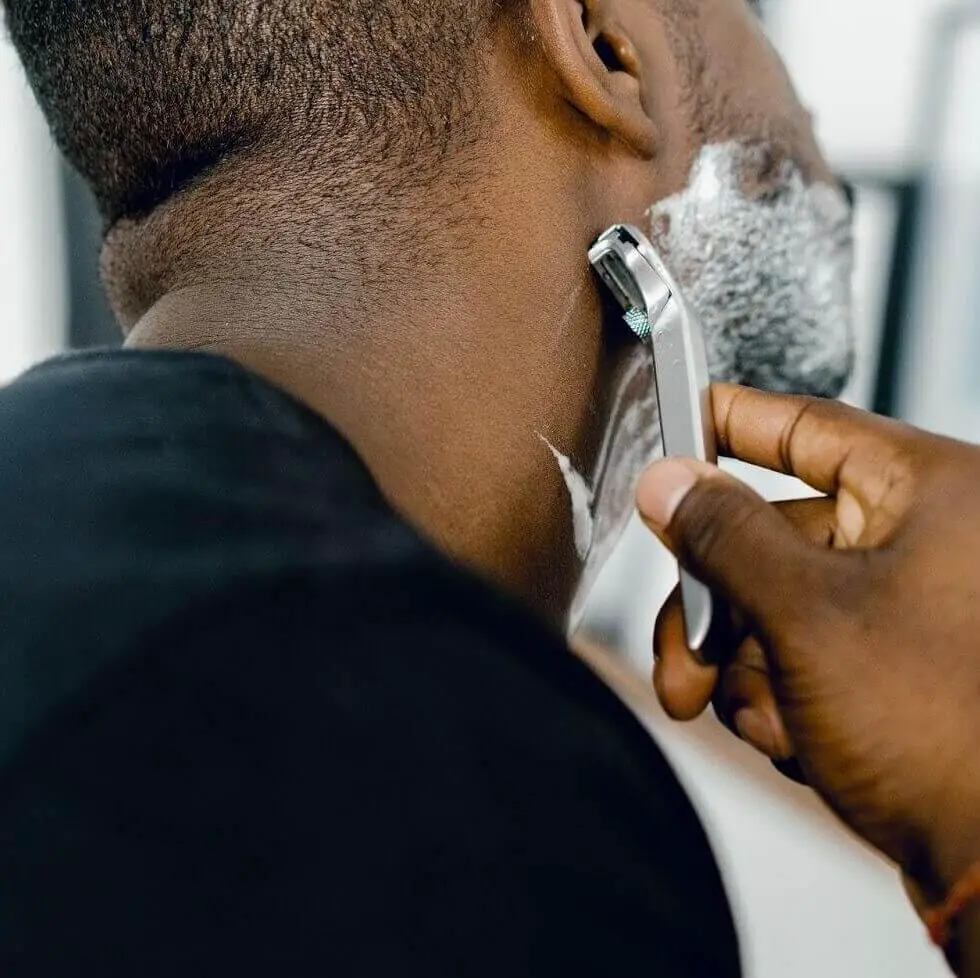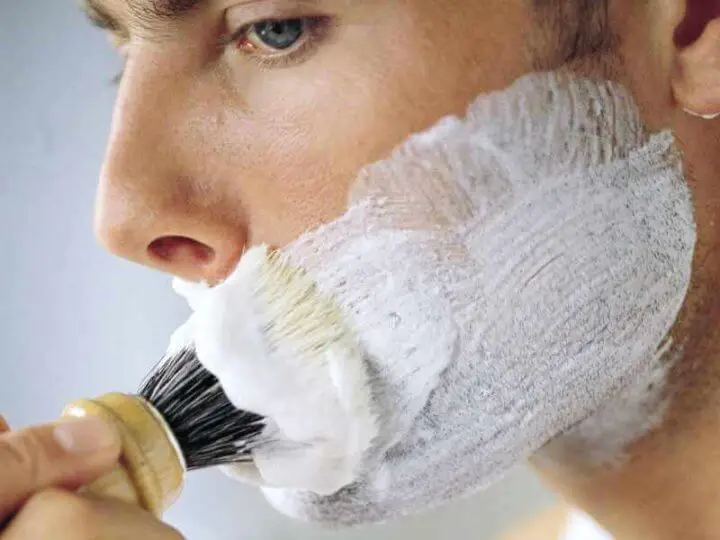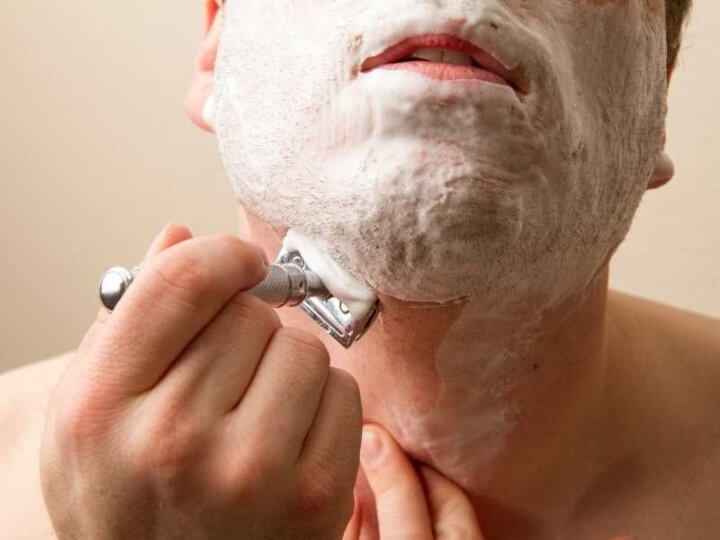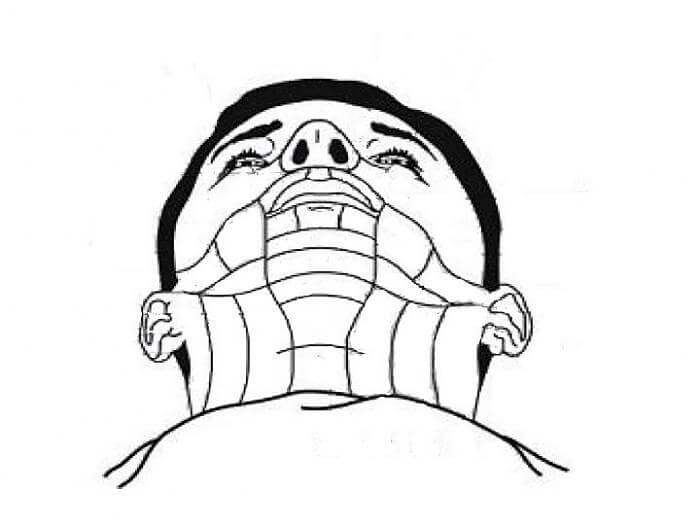
“The true secret of happiness lies in taking a genuine interest in all details of daily life”
— William Morris
Why use a safety razor?
Traditional shaving offers two advantages over shaving with a cartridge razor and canned foam: it can be substantially less expensive (because of the price difference between cartridges and DE blade), and it can be much more pleasurable.
However, traditional shaving involves learning a new skill. The key is to enjoy the learning: see “Learning a New Skill Is a Struggle — Find Pleasure in It.” And in the process of acquiring a new skill, one almost always encounters some common problems. Indeed, one weakness suffered by self-taught practitioners is that they don’t realize some of the common errors they are making, thus the value of a good coach.
I started participating in shaving forums just over 25 years ago, and gradually went from learning to helping. I like to try new things — I am a natural experimenter — and as a result of the experiments I did and the questions I encountered, I learned a lot, particularly through comparing techniques and tools on my own and then seeing how my discoveries worked for others.
For quite a few years I responded to novice questions and concerns posts in Reddit Groups, primarily the Wicked Edge. I published Leisureguy’s Guide to Gourmet Shaving (Ed. note: Amazon affiliate link) years ago, and as I learned more and as new products appeared, I continued to update it. The current edition is the 7th, and this article is based on one chapter from the Guide, though considerably revised and extended. I continue to blog regularly about shaving, and from time to time I still discover something new.
This article discusses some common difficulties that you might encounter in mastering traditional shaving:
- Insufficient prep
- Poor lather
- Wrong brand of blade for you and/or your razor
- Incorrect blade angle
- Too much pressure
- Ignoring your beard’s grain
- Bathroom too loud
- Setting an adjustable razor too high
- Razor repeatedly becomes clogged
- Not finding the optimal approach for you
Most problems can be solved by judicious experimentation once you realize it is a problem. In the following, I’ll suggest how you can experiment regarding these specific problems, but the general rule is: Pay close attention to what you’re doing and to what results. That kind of attention is not only an effective way to learn, it is also the gateway to one of shaving’s pleasures: that focus clears the mind and lets you settle into the moment, a state of mind and sensation that Mihály Csíkszentmihályi named “Flow.” (See, for example, his book Flow: The Psychology of Optimal Experience.)
In the final section, I suggest some experiments you might try.
1. Insufficient Prep

Your stubble must be fully wetted to soften. Shave after showering, wash your stubble at the sink with a high-glycerin soap, and apply a good lather — dense and holding a substantial amount of water — to your washed, wet beard.
Take your time lathering before the first pass; the lather for later passes can simply be applied without much ado, but before the first pass, work the lather into the stubble so it has time to do its job. Make sure you prep your neck shaving area well because beard grain on the neck is often irregular so that even in the first pass you might have to shave some parts against the grain (as when the stubble grows in a whorl).
One sign of insufficient preparation — when a lather’s too dry and/or the lathering process is too brief — is that the blade seems dull, pulling and tugging at the beard (“why is my safety razor cutting me?”) instead of cutting smoothly and easily. It may be, of course, that the blade is dull, particularly if you’ve been putting off changing it. Or if it’s a new blade, it may be a dud (rare, but it happens), and if it’s a new brand, it may not work for you in that razor.
But if you’re using a brand of blade that’s worked well for you, and it abruptly seems dull when you start a shave, suspect the prep. Make sure the lather’s wet enough, and spend a good amount of time with the brush, working the lather over and into your stubble. When you lather before each pass, lather your chin and upper lip (the toughest part of your beard) first and shave them last. That gives those whiskers more time to soak in the lather and thus soften.
Using a hot towel is a pleasant luxury and also good prep, but it takes some time, so you might relegate it to a weekend or evening shave. Apply lather, wet a face towel with hot water, wring it out, lay the towel over the lather, and let the towel sit for 2-3 minutes. Meditate and enjoy the warmth, then remove the towel, re-lather, and shave.
2. Poor lather

Poor lather generally results from:
- Hard water; or
- Insufficiently loading the brush; or
- A mediocre shaving soap
Hard Water
Hard water is a “hidden” problem because many shavers take water quality for granted. They assume mediocre lather must be because they’re doing something wrong and don’t consider that the problem might be the water’s hardness.
If a shower makes you “squeaky clean,” the “squeak” is due to friction from soap scum adhering to your skin. That makes hard water the prime suspect — and if you find white mineral deposits around faucets, hard water definitely is a problem.
To see whether hard water is the source of a lather problem, try a shave using “purified” water (sold in drugstores for steam irons, vaporizers, and the like). For best results, add a dollop of tap water to some purified water in the sink — distilled/purified water by itself tends to make a frothy lather.
If the lather with purified water is markedly better, you can use purified water regularly. It takes very little water to make lather, and between passes you need merely to wet your face, not rinse well. (GIs in WWII shaved using 1 mug of water.) The only disadvantage is having to heat the water — but (as mentioned below) you can try a cool-water shave.
Or, instead of using purified water, you can add a pinch of citric acid to a sink half-filled with tap water to soften it. If you’re a homeowner, a water softener is worth considering, since hard water is hard on plumbing (those mineral deposits collect in the hot-water heater, in faucets, and in plumbing). Moreover, hard water doesn’t do laundry or dishes well. (Usually, a softener is installed to soften all water except outside faucets and kitchen cold water.)
Some who shave with unsoftened hard water find that it helps to put a driblet of water on the soap and let that sit for a few minutes. Also, some soaps contain ingredients (such as tetrasodium EDTA, etidronic acid, and others) that help counteract the effects of hard water.
A brush loaded with insufficient soap
A brush loaded with insufficient soap will make mediocre lather. If a high-glycerin soap leaves your skin feeling slick, the problem is probably not due to hard water, so in that case, before trying purified water, make sure you’re fully loading the brush with soap.
Boar and horsehair brushes should be soaked before use — wet the knot well and let the brush stand sopping wet for a few minutes (while you shower, for example).
To load the brush, wet its knot under the hot-water tap, give the brush 2 or 3 good shakes so that it is damp rather than wet, then brush the puck of soap briskly and firmly for 10-15 seconds (or until bubbles are gone and you see only fine-grained lather). You may have to add a driblet of water as you load, particularly if the soap contains clay, but big bubbles indicate that you’ve added too much water, and the lather will be loose rather than thick.
Continue brushing the soap until the knot seems fully loaded with soap. Here, your best bet is to experiment: observe the amount of soap in the knot and the quality of lather you get, and soon you’ll know from experience how much soap to load. It helps if you view it as a puzzle to be solved.
Work up the lather on your face (or in a bowl or on your cupped palm), and perhaps add a little water if it’s needed (that is, if the lather seems too dry). With practice, you can load the brush quickly — my regular loading time is 10 seconds, even with dry soap and a soft brush. I do, however, have soft water.
Mediocre shaving soap
Mediocre shaving soaps will occasionally crop up on Etsy or at farmer’s markets or the like. Inexperienced soapmakers — particularly those who do not shave — often do not understand what a good shaving soap requires. They will add clay to a bath soap formula and call it a shaving soap. It’s not. It’s a bath soap with clay.
To avoid this problem it’s helpful to buy from reputable vendors and shaving-soap makers and to read reviews of shaving soaps. There are many excellent shaving soaps now being made by small independent artisans, and the best of those are better by far than soaps from big commercial houses.
The worst situation, of course, is using hard water to insufficiently load a brush with mediocre shaving soap. But with patience and experimentation, you can untangle the causes of poor lather.
3. Wrong Blade for You or Your Safety Razor
Why is my new razor not working? Blade selection is important. Novices focus on the razor, but the razor is just a device for holding the blade and presenting the edge at a good angle with appropriate blade gap and exposure. Men differ in skin sensitivity and in the thickness and toughness of their stubble, so they differ also in the razors and blades that work best for them.
Get a sampler pack of blades so you can try several brands to find the one that works best for you in the razor you use. Don’t skip this essential step if you want close and comfortable shaves. You cannot rely on recommendations from others. What works for them, in their razor, might not work at all for you, with the razor you use.
This idea is difficult to grasp — if you have a terrible shave with a brand of blade, it’s hard to believe that others would actually like the brand, and if you have a wonderful shave, you want to recommend the brand to everyone. And yet it’s true that every brand of blade has those who love it and those who hate it. Until you try the blade, you don’t know to which group you belong.
4. Incorrect Blade Angle
Blade angle is critical. The blade should be almost parallel to the skin being shaved so that the blade is close to perpendicular to the stubble as the blade slides over your skin. Generally speaking, keep the cap’s edge — just behind the exposed blade — in contact with your skin. Focus on that and forget about the guard (bar or comb). Think of the blade as gliding along parallel to the skin, the cap riding on a thin layer of lather.
The sound the blade makes in cutting the stubble helps in tuning the angle. The best angle is close to the angle at which, if you move the handle any farther from your face, the blade stops cutting. You can play around with that angle: handle a little closer, the blade is cutting the stubble; handle slightly farther away, cutting stops. Move the handle back and forth over a narrow angle and you will soon find a comfortable spot with a good sound of cutting and the razor’s cap nicely against your face.
Generally speaking, DE razors are held with the handle farther from the face than cartridge razors. Thus someone accustomed to a cartridge razor will at first have to be conscious of holding the handle away from the face. The cutting/stop-cutting exercise will help: keep the handle just at the verge of stop-cutting.
Different razors may require holding the handle at a different angle. The RazoRock Stealth, for example, has its handle closer to the face than most other DE razors. If you find a new razor tends to give you nicks, suspect that you’re holding the handle too close to your face, and try the start-cutting/stop-cutting exercise.
Some men find that they tend to get nicks in the pass across the grain, but not so much in the passes with the grain and against the grain. The reason almost certainly is that the horizontal handle position common in the across-the-grain pass has led them to hold the handle closer to the face, thus producing a steeper blade angle — and nicks.
Where the skin has a lot of curves (for example, jawline, neck, chin), you have to maneuver the razor a fair amount to keep the blade angle correct because the safety razor, unlike the cartridge razor, does not pivot. (There are some exceptions: the OneBlade razor does pivot, for example — but even with that razor, mind the angle.)
Making short strokes helps you stay focused on blade angle. Even with light pressure, if the angle’s wrong, you’ll nick or cut yourself. As you gain experience, you will find that you can make longer strokes, just as (say) a violinist must at first practice a new piece slowly, but as he learns it, he can pick up speed and finally play the piece at tempo.
5. Razor Pressing Too Hard On Your Skin

Shaving with a cartridge either requires or encourages pressure, usually in an attempt to get a few more shaves before replacing the (expensive) cartridge. As a result, using too much pressure is a habit that cartridge shavers must unlearn. The same problem arises when men start with an inefficient DE razor like the Micro One-Touch/Van Der Hagen razor. The best razors are both efficient and comfortable (that is, they feel good on your face and they’re not inclined to nick).
Often the weight of the razor by itself is enough to cut the stubble. For some razors, the weight of the razor is too much, so the razor must be supported in the hand. (The iKon stainless slants are like this.) Hold the razor with a gentle but secure grip — as you would hold, say, a canary: tight enough so that it doesn’t escape, gentle enough so that it is not injured. Hold the razor around the balance point on the handle to better control the pressure.
When you rinse your face after the first pass, you’ll feel stubble. This does not mean you should use more pressure. Instead, it means, “Do another pass.” You eliminate stubble by progressively reducing it over 2, 3, or 4 passes, 3 being most common.
Oddly, a very light razor, such as a bakelite razor the RazoRock Baby Smooth, might encourage too much pressure. An efficient razor does a good job even if the razor is barely brushing the skin, so on using a very light razor some will unconsciously apply more pressure so that they can feel pressure, and that can easily be too much. You want the razor just barely touching the skin. A DE razor allows — requires — that you control blade angle directly, and the same applies to pressure: control it directly to keep it light. Your face will thank you.
6. Ignoring Your Beard’s Grain

It’s vital that you know the direction of your beard’s growth, since the sequence of passes is first with the grain, then across the grain, and then (if stubble is sufficiently reduced and you don’t have to be concerned about razor bumps) against the grain. (If too much stubble remains for a comfortable against-the-grain pass, first shave across the grain the other way.)
Men who tend to get in-grown whiskers or razor bumps in some areas should not shave against the grain in those areas. For a smooth finish, on the third pass they can shave across the grain in the other direction.
Generally, the beard on your face will grow downward — but not always. I have a couple of patches where it grows more or less sideways. The grain on the neck might have any pattern, including whorls and chaotic growth. For those places, good prep is especially important.
To find the grain directions of your own beard, wait 12-24 hours after you’ve shaved, then rub your face and neck with the tip of a finger. At each point, the direction that’s roughest is against the grain at that point.
You’ll find the “roughest” direction is different on different parts of your face and neck. Print the diagram above and mark an arrow in each region to show the grain’s direction there. Once you’ve made the map, you will know the directions of your beard’s grain, and you probably will not have any further need for the map, though for a few days you might find it helpful as a reference.
7. Bathroom Too Loud

If your bathroom is not quiet — if, for example, water is running or the fan is on or you’re listening to music — then you cannot hear the (quiet) sounds of shaving. Shaving deaf, as it were, is like flying blind: it doesn’t work so well. Auditory feedback helps you fine-tune the blade angle.
Moreover, one benefit of shaving is the mindfulness meditation that can follow from a close focus on what is happening — cf. “flow,” mentioned above. Music distracts from the experience of flow.
Shaving in silence may at first be difficult if you are accustomed to distraction. But as you gain practice in paying attention to what you’re doing, you will find that the act of shaving is satisfying in itself, with only the quiet sounds of water, brush, and blade.
8. Setting an Adjustable Safety Razor Too High
Some novices inexplicably dial their adjustable razor to its most aggressive settings — 5 or 6 on the Merkur Futur or Progress, 8 or 9 on a vintage Gillette adjustable — and then are shocked when they see in the mirror their lacerated face.
With an adjustable razor, start with a low setting (1 on Futur or Progress, 2 or 3 on Gillette Adjustable), and advance the setting only as you must to get a good shave. As soon as you easily get a satisfactory shave, stick with that setting. You want the lowest setting that works, not the highest you can stand. It’s not a contest with a prize awarded for enduring a high setting.
9. Razor repeatedly becomes clogged During A Shave
If your razor doesn’t rinse well, becoming clogged with lather and stubble, first check the lather. If the lather doesn’t rinse away easily, the problem is likely due to (a) hard water (which produces a sticky scum when mixed with soap) or (b) too thick a lather (too much soap for the amount of water) — or both.
Solutions to the hard-water problem are described above. For too thick a lather, experiment by loading the brush for a shorter time and/or working more water into the lather. You can experiment by using a round-bottomed bowl as a lathering bowl. Start with a dryish lather — that is, deliberately load the brush using very little water. Then, brushing the bowl, work in small amounts of water, little by little, until the lather is obviously too wet. Feel the lather as you go. Along the way, you should discover a lather that is slick and easily rinses away but is still thick enough to work as a lather. That becomes your target lather. With some experimentation and practice, using soft(ened) water, you can create lather that does the job and also rinses easily away, not clogging the razor.
The problem also can be caused by using too much pre-shave oil, since oils don’t easily rinse away. Try skipping the pre-shave oil and instead wash your stubble at the sink using a high-glycerin soap. Rinse partially with a splash and then apply lather. If the clogging doesn’t occur, the pre-shave oil was to blame.
10. Not finding the shave approach that’s optimal for you
Men differ in many ways, and those differences include differences in skin (sensitivity to pressure and fragrances, response to temperature), beard (thickness, toughness, grain direction), skill (which differs even in one man over time), patience (more is better), and preferences in general (type of brush, or razor, or fragrance, or soap).
A hidden problem occurs when a man does not explore sufficiently to discover his own preferences and what works best for him but instead settles too quickly on what he’s already tried. This problem can be avoided if, over time, he tries different things, spending enough time on each to let the novelty wear off and then judging whether it works well for him.
Here are some things you might want to try. There’s certainly no rush to complete the list, but exploration will help you learn your own preferences and what works best for you.
- Try applying a hot, moist towel over the initial lather for a few minutes, then remove the towel, re-lather, and shave. This was described above, and it’s worth trying.
- After loading the brush, build the lather a) on your face; b) in a bowl; or c) in your cupped palm. Try each method for a few days until the novelty wears off, and after trying all three, decide which you prefer. (I prefer on my face, many men prefer a bowl.)
- Try using different sorts of brushes: synthetic, boar, badger, and perhaps horsehair. For boar, I like the Omega Pro 48 (10048), but note that boar brushes initially are lathercidal. So for the first several days, load a new boar brush with soap and work up a lather in your cupped palm. Then rinse the brush — with hot water until the water runs clear, then with cold water — shake out excess water, and let the brush dry until the next day, then repeat the exercise for a week. This removes whatever kills the lather.
- Shave using cool or cold water. This is especially nice in the summer, of course, but some men find it helps their skin and like the feeling.
- Shave before showering instead of after showing. Some men find this works better for them.
- Periodically try a brand of blade that you’ve not tried before.
- Try an ultra-premium shaving soap: Declaration Grooming’s Milksteak formula, Phoenix Artisan’s CK-6 formula, an Ariana & Evans soap, one of the Grooming Dept formulas.
You will experience a learning curve as you move from cognitive understanding to practiced skill, but with the information above, you will know what you’re trying for.
Michael Ham, author of Leisureguy’s Guide to Gourmet Shaving, hated shaving when he first started and quit as soon as he could. He had a beard for more than three decades. Once he resumed shaving, rediscovered the traditional tools, and learned good technique, he realized that a traditional shave offers a pleasurable ritual to begin a new day. This article is based on an extract from the Guide, though it’s been considerably revised and extended.
Images
Man shaving: Photo by Supply on Unsplash
Water faucet: Photo by Sarah Chai from Pexels
DE blades: Photo by Leisureguy.
